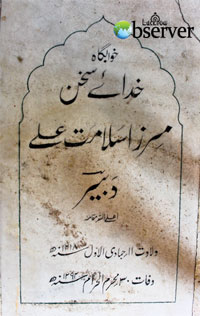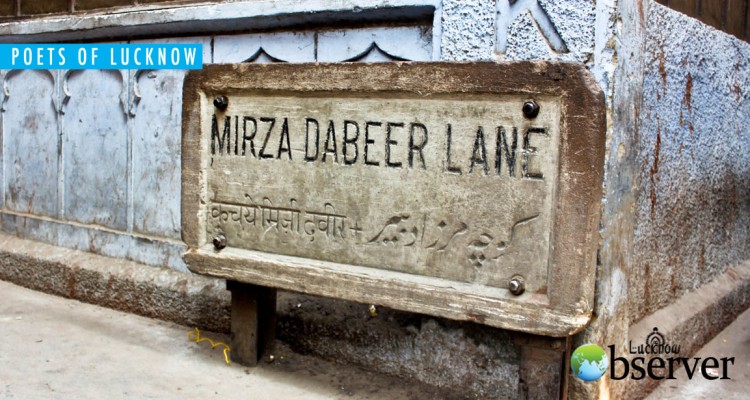Lucknow is proud on his Legendary Marsiya Poet
“Khana Hai Na Pani Na Qaza Hai Na Rihai,
Kis Dukh Mein Hain Allah Duhai Hai Duhai”
Mirza Salamat Ali poetically surnamed Dabeer was born at Delhi in 1803. There is a good deal of discussion regarding the nobility of his ancestors and attempts have been made to show that he came of a noble stock and his ancestors were well connected and highly distinguished. It must however be stated that his family was respectable and commanded some influence in bygone days. His father Mirza Ghulam Hussain, forsook Delhi on its devastation for Lucknow where he settled. He repaired to Delhi again when quiet was restored. Dabeer, however came, with his father to Lucknow when he was seven years of age and was educated thoroughly. He evinced keen enthusiasm for scholarship and the discussions he held with learned men sharpened his intelligence and wit. Poetry and especially the marsiya exercised great fascination for him and he became pupil of Zamir, the great rival and contemporary of Khaliq. He however outstripped other pupils by the quickness of his intelligence and attained a proficiency which earned great praise from his teacher and other poets.
“Mujh Ko Yateem Jaan Kar Har Ek Satayega,
Yeh Kahiye Kaun Meri Himayat Ko Aayega”
He was ranked as a great marsiya writer and is mentioned by Sarur in Fasana-e Ajaib along with the memorable marsiya writers of that age. His fame advanced rapidly and he had the privilege and the honor to recite his compositions before Nawab Ghazi-ud Din Haider and Nawab Wajid Ali Shah. Many noble men and ladies of the royal household became his pupils and he came to be regarded as an authority on the Urdu language. His reputation as a poet and his intimacy with his teacher excited the envy of some of the less favored rivals who created bad blood between him and his teacher on the subject of a marsiya which he recited in the assembly of Nawab Iftakhar-ud Daulah. In the end however they were reconciled and all misunderstandings were cleared. Dabeer was always respectful towards his Ustad and never permitted others to speak ill of him.
“Shamsheer Bakaf Dekh Ke Haider Ke Pisr Ko,
Jibraeel Larazte Hain Sametay Hue Par Ko”

Dabeer was already famous when Mir Anees came from Faizabad. The poetical contests and rivalries with Anees resulted in sharpening of poetical powers but the rivalries never transgressed the bounds of decorum. Both were courteous and respectful to each other and seldom appeared together. Dabeer was a perfect master of elegiac poems and had devoted his whole life for the attainment of this object. He shared all the qualities of Anees but was fond of dignified expressions and high sounding words. His verses were torrents rushing with rapidity, force and high sound. He pays particular attention to flights of fancy and freshness of ideas. It may be that sometimes the effect scored is not commensurate with the importance of the subject. The scholar often peeps out in Dabeer. He was especially adroit in intercalating Arabic verses of the Quran in his marsiyas with surprising skill and striking effect. To compose quickly and well was one of the greatest of his gifts. The fecundity of his ideas is remarkable. The picturesque and the rare similes, the majesty of the verses, the high flown metaphors, the resounding words, the elegance of the diction, the quickness of his intelligence, the facile skill in composing stirring poems, the inventiveness of his genius all entitle him to a foremost rank beside Anees amongst Urdu poets.
“Lazzat Mere Jeene Ki Liye Jata Hai Koi,
Be-Tegh Mujhe Zibah Kiye Jata Hai Koi”
The rivalries of these two great poets divided Lucknow into two camps which were respectively called Aneesia (Aneesites ) and Dabeeria (Dabeerites). Their partisanship often degenerated into ridiculous and senseless discussions; however their comparison is none the less interesting and instructive. Both lived in the same age having been born nearly at the same time and died within a year of each other. Both were devoted to the same species of composition and lived in the same environments and atmosphere. Anees however was a poet by descent and received poetry as an inheritance. Dabeer had no such pride of descent. Both were masters in their own sphere. Anees paid particular attention to the refinement, the purity, sweetness, flow, aptness and elegance of diction and idiom. Dabeer devotes more care to the invention of ideas, flights of imagination, search for new and rare similes, majesty and pomp of words. Eloquence is the watchword of Anees. Grandeur is the motto of Dabeer. It is true that the verses of Anees are free from clumsy constructions and involved metaphors while Dabeer is a victim to them for his scholarship and his love for originality betray him on such occasions. Dabeer was more learned than Anees and this want of erudition in Anees was both a source of strength and weakness to him. It is invidious to rank the one over the other and the final test is that of taste.
“Tanhai Mein Aah Kaun Hoyega Anees,
Hum Honge Aur Qabr Ka Kona Hoga
Is Qabr Ke Parde Ka Khula Haal Dabeer
Jo Odhna Hoga Woh Bichona Hoga”
In 1858, Dabeer went to Murshidabad and in 1859 to Patna. Dabeer left a worthy son in Mirza Muhammad Jafar poetically surnamed Auj who followed in the footsteps of his father. He was a great scholar and was regarded as an authority on prosody on which he had published a treatise. He was the recipient of many bounties from Patna, Hyderabad, Rampur and Awadh. Dabeer died in 1875 in Lucknow and buried in his house. The bylane near his house at Nakhas has been named after him as ‘Kucha-e Mirza Dabeer’. However, the condition of the stone is pathetic and a blot on the honour of poet. His house is in shambles and needs immediate renovation.
“Aalam Tha Yeh Us Dam Haram Khaak Nasheen Par,
Tasbeeh Giray Toot Ke Jis Tarah Zameen Par”
Atif
(Published in The Lucknow Observer, Volume 1 Issue 9, Dated 05 December 2015)

